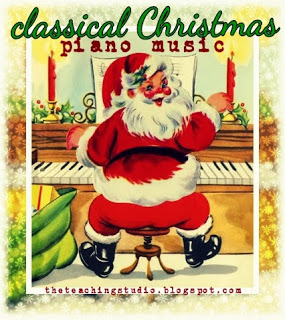Classical Christmas Piano Music
‘Tis the season for Christmas music!
Piano students in studios all over are getting out their favorite seasonal carols and songs to play. Over the next several weeks, piano teachers will hear rendition after rendition of “Jingle Bells,” “Rudolph the Red-Nosed Reindeer” and “The Twelve Days of Christmas” (with all 12 verses!). I love this time of year, I love playing Christmas music, and I love that added excitement and motivation that comes to many students when they play these wonderful songs that are familiar to them and that they love.
I’ve been thinking though. As pianists we have such a rich and wonderful collection of great literature to play and perform. I love the traditional Christmas carols just as much as the next person (if not more!). But how cool would it be to hold a Christmas recital (with your more advanced students in your studio) consisting not of arrangement after arrangement of our favorite popular carols and Christmas songs of today, but of challenging, beautiful and virtuosic classical pieces that reference the Christmas season! I have been on the hunt for classical Christmas pieces lately and am so excited about all of the amazing pieces I have discovered! I hope you can use some of these in your studio or even just in your own playing this Christmas season. Merry Christmas! Now get practicing!
Busoni – Elegy No. 4 – Turandots Frauengemach, Intermezzo
, or online in the Petrucci Music Library. Here is John Ogdon performing the piece.
Percy Grainger – Sussex Mummer’s Carol for solo piano
I was unfamiliar with this song before finding this arrangement, but what a gorgeous piece! The harmonies are lovely. This would be a unique and gorgeous piece for a student to perform at Christmastime.
Sheet music found here or in this book of classical piano Christmas music. Take a listen!
Max Reger – Silent Night
A nice classical arrangement of the traditional Christmas carol. Find the sheet music here or in this book of classical piano Christmas music
.
Like his Nuit de Noel, Busoni’s 4th Sonatina is also quite modern in harmony and also evokes bells. Composed right before Christmas in 1917, it is a gorgeous work – but definitely not your typical holiday piece! This would be a unique and different choice for an advanced pianist’s holiday recital :)Sheet music can be found in the same book as the Elegy listed above
, or online here.
Who knew that Liszt wrote a twelve-movement piece entitled “Christmas Tree?” Not I! This is a fun little discovery. Movement 3, The Shepherds at the Manger, is a light and beautiful transcription of In dulce jubilo.
Sheet music can be found here.
Rebikov – The Christmas Tree, Op. 21
A simple, gorgeous minor waltz.
Sheet music can be found here.
This is so beautiful! Take a listen.
Bach/Myra Hess – Jesu, Joy of Man’s Desiring

This piece is so fitting for this wonderful holiday season when we celebrate the birth of our Savior. It sets an amazing tone for a Christmas recital or worship service, or just for playing to bring the spirit of this holiday into your home! I think I could listen to this piece all day long. I think I need to buy this music ASAP.
Bach/Egon Petri – Sheep May Safely Graze
At the same recital mentioned above, Leon Fleisher also played this transcription of Bach’s Sheep May Safely Graze and I was in love. I played this piece at my senior recital in college. While not as synonymous with the Christmas season as Jesu, this piece to me is wonderful for the holidays. Like Jesu, Joy of Man’s Desiring it sets a warm and peaceful tone for the season.
Purchase sheet music on Amazon.com
Tchaikovsky – The Nutcracker
What is Christmastime without Tchaikovsky’s Nutcracker? This music, traditional to the Christmas season, is fun to play (as a solo or a fun and challenging piano duet) and audiences at your Christmas recitals will love it!

, as is the Langer arrangement for piano duet
. You can also get the complete ballet for solo piano
arranged by Sergey Taneyev and revised by the composer himself.
Several different arrangements of The Nutcracker Suite Op. 71a as well as the complete ballet are all available online here and here.
Classical Piano Music for the Christmas Season
 Alfred has available a neat collection of classical Christmas piano music, edited by Maurice Hinson. It includes several selections, including pieces by Liszt, Brahms, Mendelssohn, Schumann, Tchaikovsky and more. A few of the pieces that I have mentioned in this post are included in this collection! I am excited to add this book to my own music library! There are several places you can purchase this book online:
Alfred has available a neat collection of classical Christmas piano music, edited by Maurice Hinson. It includes several selections, including pieces by Liszt, Brahms, Mendelssohn, Schumann, Tchaikovsky and more. A few of the pieces that I have mentioned in this post are included in this collection! I am excited to add this book to my own music library! There are several places you can purchase this book online:
Purchase on Amazon.com
Purchase on jwpepper.com
Purchase on sheetmusicplus.com
Looking for more classical piano pieces for a Christmas or winter recital? Why not try some of these winter-related pieces!
Frank Bridge – Winter Pastoral (listen) (sheet music)
Chopin – Etude Op. 25 No. 11 (Winter Wind Etude) (Sheet music)
Debussy – Des pas sur la neige (Footprints in the Snow) from Preludes, Book 1
Debussy – Children’s Corner No. 4 The Snow is Dancing (listen) (Sheet music)
Dohnanyi – Winterreigen (Winter Round Dances) Op. 13 (listen to No. 10) (Sheet music)
Charles Griffes – A Winter Landscape
Liszt Transcendental Etude No. 12 Chasse-Neige (or “Snow Storm”) (listen) (sheet music)
Prokofiev – Winter Fairy from Cinderella



















